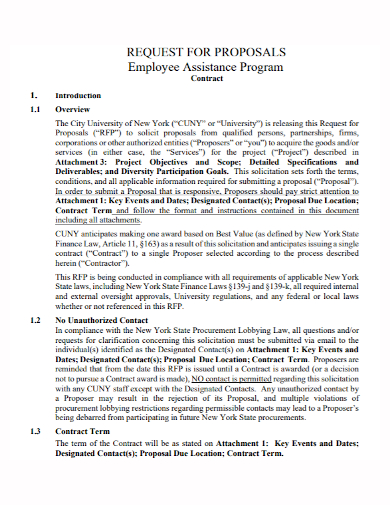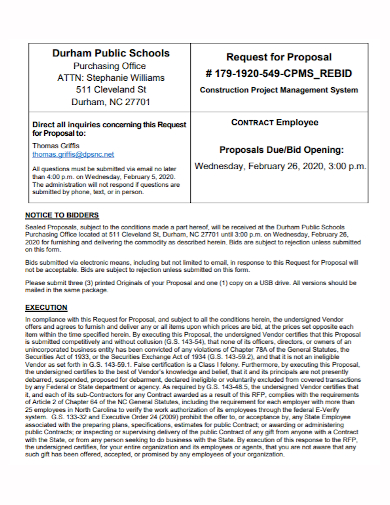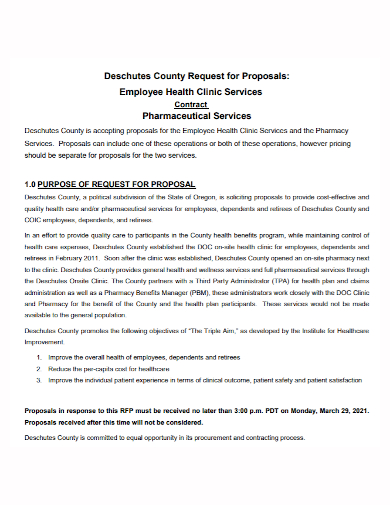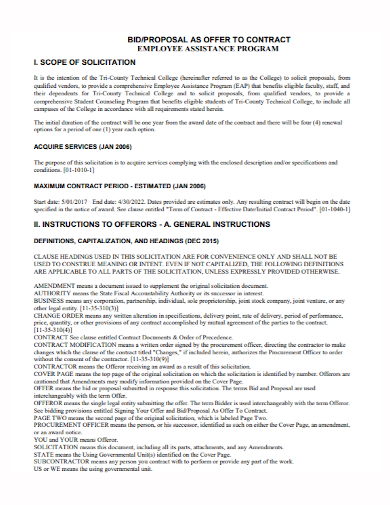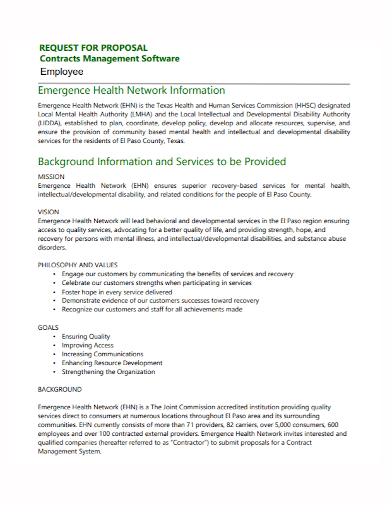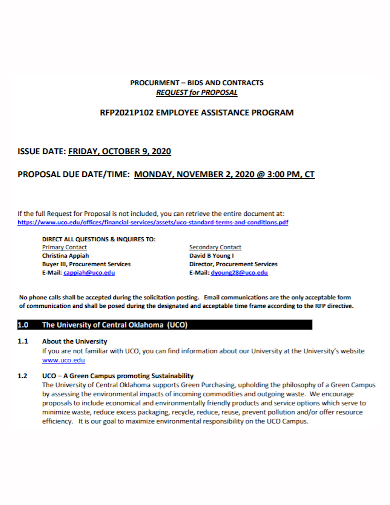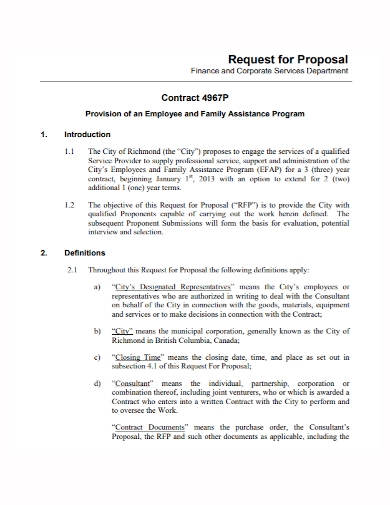An employment contract, also known as an employment agreement, is a necessary document for businesses in a variety of industries. They help employees understand the standards they’re expected to meet while working at the company and help employers reduce employment liability risks. There are a few things you should know about employment contracts before drafting one for your business. Below, we cover what an employment contract is, why they’re important and how to write one — with an employment agreement template you can use as a guide.
9+ Contract Employee Proposal Samples
1. Contract Employee Assistance Proposal
2. Contract Employee Project Proposal
3. Contract Employee Cost Proposal
4. Contract Employee Health Proposal
5. Contract Employee Request for Proposal
6. Contract Employee Bid Proposal
7. Contract Management Employee Proposal
8. Contract Employee Program Proposal
9. Contract Employee Assistance Program Proposal
10. Contract Employee Service Proposal
What is an employment contract?
An employment contract is a written agreement signed between the employee and employer regarding the rights, and responsibilities and obligations of both parties during the period of employment. An employment contract typically includes the following elements:
- Duration of employment, if applicable
- Salary or wages
- General job responsibilities
- Work schedule
- Benefits
- Confidentiality
- Non-compete agreement
- Severance pay, if applicable
- Termination details
Employment contracts are typically signed by both parties after the job offer has been accepted and before the employee’s first day of work (or within the first few weeks on the job).
All employees should generally sign an employment agreement. However, terms and conditions in your agreement could differ based on the type of employee you’re hiring. Here’s a breakdown of the most common types of employees:
- Full-time: Employees who meet the requirements for full-time hours (usually 40 hours per week) and are employed on a permanent basis with no predetermined end date.
- Part-time: Employees who work fewer than 40 hours per week (typically 25-35 hours per week) and are employed on a permanent basis with no predetermined end date.
- Fixed-term: Employees who are employed for a specific period of time with an agreed-upon end date. These employees are different from independent contractors, because they are treated as employees throughout the duration of employment.
How to write an employment contract
1. Title the employment contract
Give your employment contract a title so the person who reviews or signs the document understands what it is. For example, you could name the document “Employment Agreement” or “[Your Company Name] Employment Contract.”
2. Identify the parties
Employment agreements usually state which parties are entering into the contract. Consider clearly writing out your business name and the name of the person you’re hiring.
3. List the term and conditions
Some of the minimum terms and conditions for employment contracts are set by federal and state governments. These terms and conditions involve things such as working hours and severance packages. Terms and conditions vary by jurisdiction so it’s important to check your state and local laws regarding employment. Other terms and conditions beyond labor laws are up to you to decide. These things often include benefits, sick pay, dress code and other terms.
4. Outline the job responsibilities
Present a new hire with an outline of their job responsibilities to ensure they know what’s expected of them. If you want to present a more comprehensive outline of responsibilities, you could assign percentages to each responsibility. For example, let’s say your employment agreement is between you and a customer service representative.
5. Include compensation details
Make sure you clearly state compensation details in your employment contract. This way, there’s no confusion regarding the new hire’s first or second paycheck. Here are the things you should consider including in the compensation portion of the contract:
- How the employee will be compensated
- How overtime is calculated
- Which holidays are paid and unpaid
- How the employee will be paid (e.g., direct deposit)
- If there are annual bonuses
6. Use specific contract terms
Employment contracts generally have specific contract terms such as effective date, type of employment, notice, termination, dispute process, applicable law and severability.
7. Consult with an employment lawyer
After you’ve completed the first draft of your employment contract, have an attorney or legal professional view the contract to make sure it’s in accordance with all applicable laws. This may help protect your business from future litigation regarding employment contracts.
FAQs
What are the benefits of employment contracts?
Here are a few reasons why having employment agreements is advantageous:
- Employment contracts are legally binding documents that will protect both parties from any legal action that one will do to another party.
- it lets employees know exactly what is expected of them and what actions will be taken if they don’t comply to their expected tasks.
- If you deal with confidential information, you can choose to add a confidentiality clause that prohibits your employees from disclosing sensitive information to anyone outside your company or organization.
Do employment contracts renew each year?
Employment contracts are valid for as long as an individual is employed with your company. There is typically no need to re-write employment contracts each year under most circumstances. If an employee is promoted, you may consider updating their job description and request they sign the updated form.
What is the difference between a job offer letter and an employment contract?
Job offer letters are an unofficial way of presenting candidates with the basic terms of employment — without any legal obligations. An employment contract, on the other hand, is an official, legally binding document that includes more detailed terms and conditions of employment that must be agreed to by both the employee and the employer.
Once you’re done creating the contract, don’t print it out yet and let the new general manager sign it. Review it first for any grammatical or spelling mistakes, check the language used if it sounds appropriate, and read if the content is written concisely. Do some revisions if you’ve spotted mistakes. When the time comes for the general manager to sign, encourage them to ask questions before they sign the contract. Once the contract is signed, congratulations! A new manager is employed and ready to lead their staff and the business. To help you get started making the contract, download our free sample templates above to use as your guide!
Related Posts
Proposal Samples
Sports Event Proposal Samples
Small Business Proposal Samples
Title Project Proposal Samples [ Community, School, Student ]
FREE 10+ Product Supply Proposal Samples in MS Word | Google Docs | Apple Pages | PDF
FREE 10+ Health Project Proposal Samples [ Public, Mental, Healthcare ]
FREE 11+ Engineering Project Proposal Samples in PDF | MS Word
FREE 4+ Racing Sponsorship Proposal Samples [ Team, Car, Driver ]
FREE 10+ Nursing Project Proposal Samples [ Community, Health, Clinical ]
FREE 11+ Student Council Proposal Samples in PDF | DOC
FREE 10+ Facilities Management Proposal Samples in MS Word | Google Docs | Apple Pages | PDF
FREE 8+ Joint Venture Proposal Samples [ Commercial, Real Estate, Construction ]
FREE 10+ Scholarship Proposal Samples [ Project, Grant, Sponsorship ]
FREE 10+ Computer Purchase Proposal Samples in MS Word | Google Docs | Apple Pages | PDF
FREE 10+ Network Project Proposal Samples [ Design, Security, Bank ]

